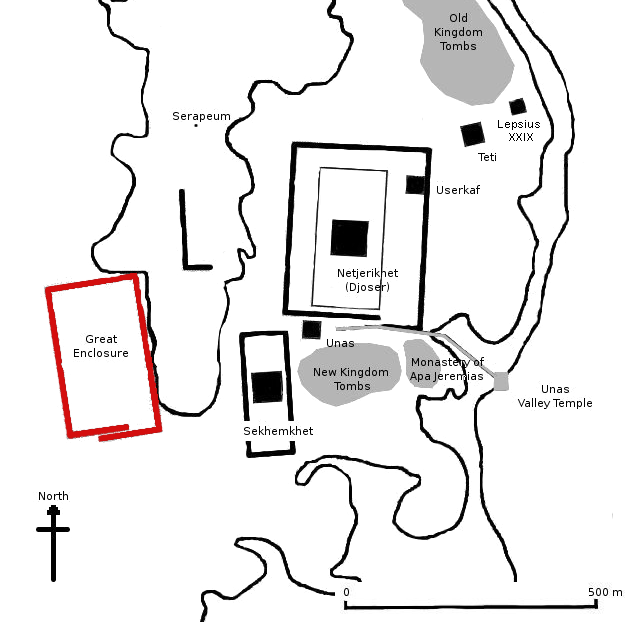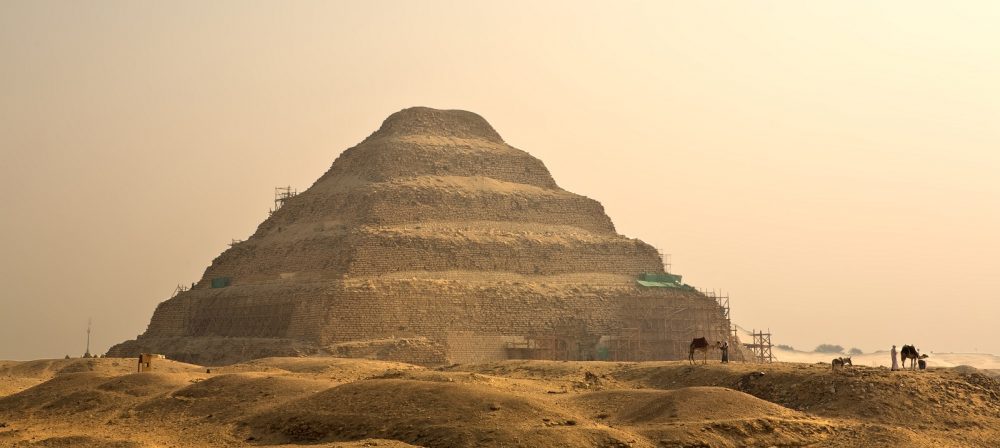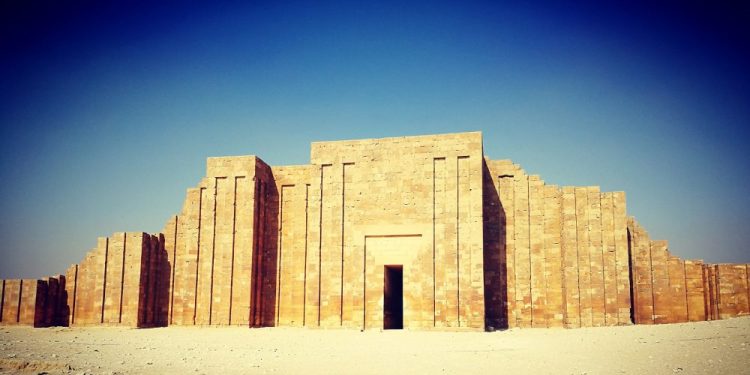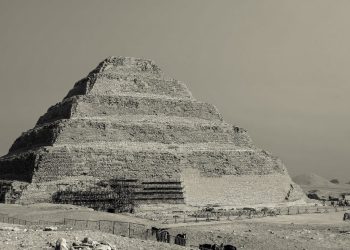This city of the dead in stone and sand is the otherworldly counterpart of the living city of Memphis in ancient Egypt.
The Saqqara plateau was home to eleven ancient pyramids, which is more than any other site in Egypt. This, of course, is without counting the satellite pyramids, queens’ pyramids and the royal mastaba of Shepseskaf.
In addition to the many pyramids at the necropolis, there are hundreds of tombs that range in date from the 1st dynasty to the Coptic Period. Tombs of important and lesser officials have been found on the site.
The city of the dead in stone and sand is huge. The entire necropolis stretches across the central plateau for 2.5 km from the northern top of the row of first dynasty tombs to the south of the pyramid complex of Sekhemkhet, and for the same distance from the eastern escarpment to the enigmatic great empty enclosure, the so-called Gisr el-Mudir, west of ancient Egypt’s first pyramid, the Step Pyramid of Djoser.
If we combine the pyramid fields of Abusir to the north, and South of Saqqara, its natural extensions, the necropolis is over 7.5 km (4 miles) long, resulting in one of the largest, most complex sites in Egypt.
It is precisely this that was seen as the otherworldly counterpart of equally great cities like Memphis, which belonged to the living. It was a division and reflection. The city of the living had to have had a city of the dead.
Located no more than 30 kilometers from southern, modern-day Cairo, Saqqara is a treasure trove in history. It was there where the oldest complete stone building complex in history was erected, the pyramid complex of Horus Netjerykhet, or as he would later be known in history; Djoser.
But in addition to Djoser, as many as 16 different Ancient Egyptian Pharaohs are thought to have planned and built their pyramids at Saqqara. These structures are now in various states of preservation or dilapidation. The Step Pyramid of Djoser remains the only one standing to date, despite having been built more than 4,600 years ago.
During the entire pharaonic period, the necropolis of Saqqara would be used by high officials in Egypt as the place where they would erect their funeral monuments. Even well into the Ptolemaic and Roman era, the site remained an extremely important complex for non-royal burials as well as cult ceremonies.
Saqqara is geographically in a strategic position in Egypt. North of Saqqara, we find Abusir, and to the south is Dashur. Both Abusir and Dashur were important sites in ancient Egypt. The land spanning from Giza to Dashur was used as an important necropolis at different times.
Abusir is home to 14 pyramids in total which served as the main royal necropolis during the fifth dynasty, long after the construction of the Great Pyramid of Giza.
Dashur, on the other hand, is home to some of the most important pyramids in ancient Egyptian history, the Bent Pyramid of Sneferu and the Red Pyramid, a structure that laid down the foundation for the construction of the Great Pyramid of Giza.
The first more complex burials at Saqqara, featuring intricate underground galleries can be traced back to the Second Dynasty.
Saqqara is also home to a superstructure known as the Gisr el-Mudir, a massive unknown structure that is believed to have eventually inspired the monumental enclosure wall that was once located around the Step Pyramid complex.
Although the stone pyramid was born at Saqqara, pyramid builders abandoned the site for almost the entire 4th dynasty as the pyramid building was transferred to Meidum and then to Dashur, as Pharaoh Sneferu ruled the land. Following Sneferu, Giza was the center of pyramid building for three generations during which the greatest pyramid in ancient Egypt was built.
Only with the end of the fourth dynasty, around 2,472 BC did Pharaoh Shepseskaf decide to return to Saqqara where he built his supermassive mastaba, abandoning a long line of pyramid building.
It was Pharaoh Userkaf, in the fifth dynasty, who returned to the central heart of the Saqqara necropolis to build his pyramid near the east wall of the Step Pyramid complex.
As generations changed, and ancient Egypt’s history saw different dynasties reign over the land, Saqqara saw kings come and go, building different monuments at Saqqara.
The pyramid of an eighth dynasty ruler Ibu, and the east of Teti’s, if it belongs to Merikare and so dates to the 9th dynasty, are considered the last pyramids built at Saqqara.
In other words, at Saqqara, we can find the very beginning of ancient Egypt, not only in terms of religion, and society but also in terms of architecture.
It is there where we find what many argue are the precedents of ancient Egyptian pyramid building.
Of all the discoveries made at Saqqara, it is probably difficult to pick out three of the most striking finds.
But nonetheless, some discoveries are more complex and important than others, not that I am trying to make less of one structure compared to another. Simply put, some of the structures at Saqqara are true ancient archaeological wonders and rank highly on my personal list.
The Serapeum
Located west of the first ancient Egyptian pyramid, the step pyramid of Djoser is a site unlike any other in Egypt. Discovered by Auguste Mariette, in 1850 the Egyptologist was exploring Saqqara when we found the head of a sphinx statue protruding from the ground. Mariette eventually cleared the sand and discovered a boulevard leading to the site. He blasted his way into the catacomb and eventually explored and excavated the complex.
Regrettably, although Mariette documented his excavations his notes were lost, so it is difficult to establish an accurate chronology of the site.

The underground complex features as many as 24, massive sarcophagi. Inside them are not the remains of rulers, gods, or aliens, but the remains of Bulls. Specifically of Apis Bulls which were considered an incarnation of the ancient Egyptian god Ptah. According to ancient Egyptian mythology, the bulls would become immortal after death as Osiris Apis.
It is believed that the oldest burials at the site span back to the reign of Pharaoh Amenhotep III, the ninth ruler of ancient Egypt’s Eighteenth Dynasty.
Curiously, some of the sarcophagi at the Serapeum have been found to weigh as much as 100 tons. The lid of the granite-built sarcophagi alone weighs 10 tons.
The perfection of the massive sarcophagi and their incredible polished surfaces have forced experts to rethink how ancient Egyptians worked with different types of stones.
It is also not entirely defined how the ancient Egyptians managed to transport the sarcophagi into position.
Gisr el-Mudir
This is perhaps one of the most mysterious structures built at Saqqara. Known as the Great Enclosure, Gisr el-Mudir is considered one of the oldest-known stone structures built in ancient Egypt.
The vast enclosure’s exact purpose remains a mystery.
The Great Enclosure is made up of a wall that was oriented north-south measuring 650 meters by 350 meters. The walls of the enclosure are double walls, constructed of roughly hewn limestone placed 15 meters apart. The opening between the walls was filled with a number of materials including crushed stone, sand, and gravel.
The inside of the enclosure is a complete mystery as no construction or tomb has been found to have stood there. The walls of the enclosure were found in 1837, but the first proper excavations were carried out in 1947 and 1948 by the then-director of the Supreme Council of Antiquities Abdel Salam Hussein.
It was argued since the discovery of the structure that Gisr el-Mudir was most likely an unfinished pyramid complex from the third dynasty.

However, in the 1990s, systematic research was undertaken by scientists from the National Museum of Scotland who made use of techniques like magnetometry and ground-penetrating radar to try and understand what the purpose of the structure was.
Pottery shards discovered between the double walls of the enclosure demonstrated that the structure dated back to the second or beginning of the third dynasty, which led Egyptologists to conclude the enclosure was erected at the end of the Second Dynasty.
The builder of the enclosure or its exact purpose remains a profound mystery.
Although we don’t have written evidence as to what the structure’s purpose was, scholars argue that the rectangular monument most likely represents a transitional state between the enclosures built at Abydos and the step pyramid complex of Djoser.
The First Pyramid
As noted by archeologists who have excavated royal tombs throughout Egypt, there is evidence that suggests that the design of 1st dynasty mastabas at Saqqara is indicative of early elements of pyramids.
Mastaba 3038, specifically, marks an important transition in ancient Egyptian architecture and design.
Built around 3,700 BC, this mastaba is believed to have been almost designed and built as an elongated pyramid, had the early builders not left one of its sides uncovered.
It didn’t take long for mastabas to evolve into superstructures. Djoser’s royal vizier Imhotep would eventually revolutionize ancient Egyptian architecture and construction methods. The 6-tier, 4-sided pyramid is recognized as the earliest colossal stone building ever constructed in Egypt.
The Chancellor and great Seer of the sun god Ra, Imhotep, would go on and design a structure with a total volume of 330,400 cubic meters. Clad in polished white limestone, the step pyramid of Djoser is considered the earliest large-scale cut-stone construction in Egypt and possibly draws precedents from the nearly great enclosure of Gisr el-Nudir, which predates the step pyramid complex by several generations.

The Step pyramid of Djoser was built in six stages, resulting in six widely-recognized steps. It was an experimental structure that was initially built as a square mastaba, which was gradually enlarged. Since the original structure is believed to have been a square mastaba, archeologists argue the pyramid was never intended to be one, since there are no known square mastabas anywhere in Egypt.
What lies beneath the pyramid of Djoser is equally mesmerizing. Beneath the Step pyramid, the builders created an intricate network of tunneled chambers, galleries, and magazines totaling nearly 6 kilometers in length, all of which were connected to a central shaft dug 28 meters below the surface. The intricately designed pyramid complex of Djoser was constructed reflecting its beauty both above the ground and below it.











